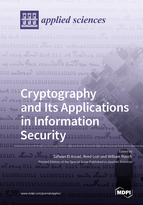Cryptography and Its Applications in Information Security
A special issue of Applied Sciences (ISSN 2076-3417). This special issue belongs to the section "Computing and Artificial Intelligence".
Deadline for manuscript submissions: closed (20 January 2022) | Viewed by 28272
Special Issue Editors
Interests: cryptography; chaos-based information hiding and security; chaos-based crypto and crypto-compression systems for images and videos; chaos-based watermarking and steganography systems; chaos-based keyed hash functions; chaos-based authenticated encryption
Interests: chaos; dynamical systems; strange attractors; cryptography-based chaos; pseudo random number generators; optimization-based chaos; memristors
Special Issues, Collections and Topics in MDPI journals
Interests: image processing; security; encryption; data hiding; compression
Special Issues, Collections and Topics in MDPI journals
Special Issue Information
Dear Colleagues,
Today, we all live today in a cyber world, and modern technologies involve fast communication links between potentially billions of devices via complex networks (satellite, mobile-phone, Internet, etc.). Thus, the question of how we protect public communication networks and devices from passive and active attacks that could threaten public safety (sabotage, espionage, cyber-terrorism) and personal privacy has become one of great significance— especially considering that governments themselves are often suspected of promoting and actively participating in the hacking of other government officials, democratic processes, industrial secrets, and citizens, with hackers targeting sensitive information of citizens, industries, and governments. This is a real threat, and it is escalating.
One of the main avenues of protecting public safety and personal privacy is that of protecting most of the communication network traffic (digital multimedia contents such as images, speech signal, videos and emails, etc.), which is vulnerable to various security threats taking place in different societies and within several societal levels.
The objective of this Special Issue on “Cryptography and its Applications in Information Security” is to address the range of problems related to the security of information in networks and multimedia communications and to bring together researchers, practitioners, and industry experts interested in such questions. We will welcome papers both from theoretical and practical aspects. Prospective authors are invited to submit original work reporting on novel and significant research contributions, ongoing research projects, experimental results, and recent developments related, but not limited, to the following topics:
- Cryptography
- Chaos-based cryptography
- Block ciphers
- Stream ciphers
- Hash functions
- Steganography
- Watermarking
- Selective encryption
- Multimedia data hiding and security
- Secure FPGA implementation for cryptographic primitives
- Security methods for communications
- Wireless network security (Internet, WSNs, UMTS, WiFi, WiMAX, WiMedia, and others)
- Security of IoT systems
- Security in 5G
- Sensor and mobile ad hoc network security
- Security and privacy in mobile systems
- Secure cloud computing
- Security and privacy in social networks
- Security and privacy in vehicular networks
- Security and privacy in web services
- Database security and privacy
- Intellectual property protection
- Lightweight cryptography for green computing
- Personal data protection for information systems
- Protocols for security
- Cryptanalysis
- Side channel attack
- Fault injection attack
- Physical layer security for communications
Dr. Safwan El Assad
Prof. Dr. René Lozi
Prof. Dr. William Puech
Guest Editors
Manuscript Submission Information
Manuscripts should be submitted online at www.mdpi.com by registering and logging in to this website. Once you are registered, click here to go to the submission form. Manuscripts can be submitted until the deadline. All submissions that pass pre-check are peer-reviewed. Accepted papers will be published continuously in the journal (as soon as accepted) and will be listed together on the special issue website. Research articles, review articles as well as short communications are invited. For planned papers, a title and short abstract (about 100 words) can be sent to the Editorial Office for announcement on this website.
Submitted manuscripts should not have been published previously, nor be under consideration for publication elsewhere (except conference proceedings papers). All manuscripts are thoroughly refereed through a single-blind peer-review process. A guide for authors and other relevant information for submission of manuscripts is available on the Instructions for Authors page. Applied Sciences is an international peer-reviewed open access semimonthly journal published by MDPI.
Please visit the Instructions for Authors page before submitting a manuscript. The Article Processing Charge (APC) for publication in this open access journal is 2400 CHF (Swiss Francs). Submitted papers should be well formatted and use good English. Authors may use MDPI's English editing service prior to publication or during author revisions.








